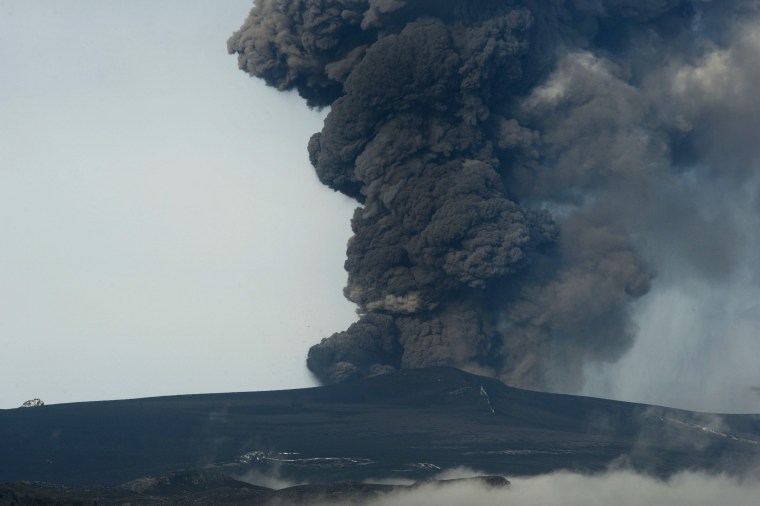A mammoth cloud of volcanic ash stretching 1,250 miles (2,000 kilometers) across the North Atlantic is forcing most flights between North America and Europe to divert into a sky-high traffic jam, Irish and European air authorities said Friday.
Forecasters warned that the rapidly spreading cloud of ash from Iceland's Eyjafjallajokul volcano was projected to reach southern Greenland and the northwest tip of Spain by Saturday. The obstacle was already forcing about 600 daily flights operated by more than 40 airlines to carry extra fuel, because the diversions were lengthening flights by up to two hours.
Air safety officials stressed that the cloud does not pose any immediate threat to shut airports or ground aircraft once again. But they said the expanding obstacle would force trans-Atlantic flights into air corridors that run unusually south into Spanish airspace or north into the Arctic.
U.S. and European airlines said they were taking the latest inconveniences in stride — even though each extra hour in the Atlantic air would mean burning more than $5,000 worth of aviation fuel, or about 2,250 gallons (8,500 liters), per plane.
"We're having to fly around it like everybody else," Continental spokesman Andrew Ferraro said.
American Airlines spokesman Tim Smith said its trans-Atlantic flights were traveling 90 minutes to two hours longer on average. He said one flight to London's Heathrow Airport had to be canceled because it wouldn't arrive in time for the airport's overnight curfew on operations.
Delta Air Lines Inc. said its approximately 20 to 25 trans-Atlantic flights daily were arriving 30 minutes to an hour late because of the new ash diversions. Delta spokesman Anthony Black said Delta is working with other airlines to keep passengers from missing connections.
In Ireland, Aer Lingus canceled two Saturday flights to and from Boston, citing the exceptionally circuitous routes to get around the cloud, and planned to combine passengers from two flights onto one.
Ireland has borne the brunt of this week's renewed invasion of Icelandic ash into European airspace. It shut down six western airports Friday, but rapidly reopened them all as the cloud remained sufficiently west of its Atlantic coastline.
Ireland and Scotland also experienced airport shutdowns Tuesday and Wednesday. They were the first such closures since a majority of European air links were shut down April 14-20, stranding 10 million passengers.
The Irish government's emergency task force on the ash crisis said the cloud already measured 2,000 kilometers by 1,300 kilometers (1,250 miles by 800 miles) and was being pushed by winds both northwest and southeast.
The Irish Aviation Authority produced interactive maps illustrating how the cloud should grow even larger, running from Greenland to Spain, within the next 24 hours. It said Irish flights to and from the U.S. should operate Saturday, but would experience delays because of the particularly circuitous routes required.
In Brussels, the European air traffic management agency Eurocontrol said trans-Atlantic airlines could no longer safely fly over the Atlantic ash cloud because it has reached 35,000 feet (10,500 meters), the typical cruising altitude of aircraft. Until this week, the ash had remained below 20,000 feet (6,000 meters).
Eurocontrol said as the ash cloud has expanded southward, it has squeezed the airspace available to trans-Atlantic flights, creating a traffic jam in Spanish airspace.
"Flights are having to be rerouted south of the no-fly zone, which means there are many more aircraft passing through the Spanish air traffic control sectors, rather than taking the usual routes over Ireland," Eurocontrol spokeswoman Kyla Evans said.
Until Eyjafjallajokul (pronounced ay-yah-FYAH-lah-yer-kuhl) stops its emissions, the key to the future course of Europe's ash crisis will be the prevailing Atlantic winds.
When the winds blow to the northeast toward the unpopulated Arctic — typical in springtime — the danger to aircraft is minimized. But when they shift southward, as happened both this week and in mid-April, airlines' ability to land and depart safely can be jeopardized.
The glacier-capped volcano, about 900 miles (1,500 kilometers) northwest of Ireland, has shown no signs of stopping since it began belching ash April 13. It last erupted from 1821 to 1823.
AP airlines writers David Koenig in Dallas and Joshua Freed in Minneapolis, Minnesota, and AP aviation writer Slobodan Lekic in Brussels contributed to this report.
